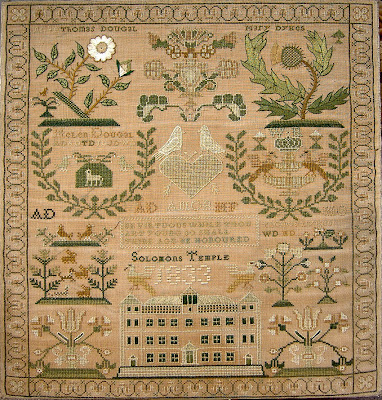William Larkin is not a name that registers immediately as that of a famous painter - there are many who are much better known to us. But he was one of the most faithful of portraitists in the time of James I of England. Born in England sometime in the early 1580's, his life was relatively short - he died before he was 40 in 1619. But I simply love the way he adores embroidery and lace! As you can see those early Stuart dresses were a little risky. There is a story that in 1860 Ismail Pasha of Egypt had the experience of a court lady curtseying rather low before him and falling out of her corsage - to whom he said:
Mais, madame, il ne faut pas perdre ces belles chose-là, comme ci, comme ça, etcetera.
But I digress - just look at this detail of the jacket with its gold work, braid stitch tendrils and bright coloured, satin stitched flowers, all sprinkled around with paillettes. And the lace of the cuff is pretty spectacular too, isn't it?
Here is another detail of the embroidery on her arm.
And then we look down and see that the design of her skirt is totally amazing - those sea creatures swimming around, creating ripples are totally fabulous in every sense of the word.
This portrait by Larkin is in Kenwood House London. Painted around 1615 it is of Lady Dorothy Cary. It would seem she is embroidered and laced to within an inch of life. I find the designs here of the jacket, skirt and cloak to be utterly magnificent
Here you can see a little more of the design - and note those extravagantly expensive double lace cuffs.
Above is another fabulously revealing jacket by Larkin - this time belonging to, it is thought, Lady Thornhagh and below is the Jacobean beauty, Elizabeth Honeywood - but note the sea-change in design on her jacket and skirt. This picture was once in the collection of Sir Elton John.
 It used to be the case that we had to wait for May Day to decorate our bicycles - but do you know what? - It has been such a long grey, miserable winter that I definitely think it is time to spring some spring-like bunting right this minute! I saw this wonderful bicycle outside a shop on a recent freezing cold day in Cockermouth - just the day before the 14 foot snow drifts - and in a town which has come close to ruin recently on account of appalling floods - and fell upon its hopeful colour and delight with as much gladness as Wordsworth must have felt upon seeing his golden daffodils. It strikes me that the simplest, home-made gestures have the power to change - to bring a smile to a stranger's face - to renew hope where hope might be lacking and to bring comfort in the cold. I hope your hope finds its own spring of renewal today.
It used to be the case that we had to wait for May Day to decorate our bicycles - but do you know what? - It has been such a long grey, miserable winter that I definitely think it is time to spring some spring-like bunting right this minute! I saw this wonderful bicycle outside a shop on a recent freezing cold day in Cockermouth - just the day before the 14 foot snow drifts - and in a town which has come close to ruin recently on account of appalling floods - and fell upon its hopeful colour and delight with as much gladness as Wordsworth must have felt upon seeing his golden daffodils. It strikes me that the simplest, home-made gestures have the power to change - to bring a smile to a stranger's face - to renew hope where hope might be lacking and to bring comfort in the cold. I hope your hope finds its own spring of renewal today.
 Just this week I saw these incredible textile horses by Nick Cave at Grand Central Station. What does your horse look like?
Just this week I saw these incredible textile horses by Nick Cave at Grand Central Station. What does your horse look like?
















































